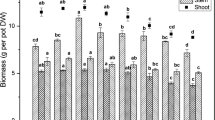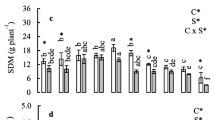Abstract
The main objective of this work was to determine whether nitrogen-use efficiency (NUE) was affected by the application of different forms and dosages of selenium (Se), to ascertain the influence of this trace element in a biofortification program in lettuce plants. The parameters analyzed were biomass, NO3 − concentration, and total reduced N as well as those defining NUE in plants: total nitrogen accumulation (TNA), nitrogen efficient ratio (NER), nitrogen-utilization efficiency (NUtE), and nitrogen-uptake efficiency (NUpE). According to our results, application of Se affected NUE in lettuce plants. With the application of selenite as well as selenate NO3 − uptake was reduced, thus diminishing the NUpE and the foliar concentration of this anion. In addition, selenate application at a rate of 20 μM and selenite at 5 μM induced N utilization, reflected by an increase in NER and NUtE; this result coincides with augmented biomass production. Notably, our results indicate that when Se is applied at high rates, selenite is far more phytotoxic, this being associated with a higher reduction of NUE in these plants.




Similar content being viewed by others
References
Andrews M, Lea PJ, Raven JA, Lindsey K (2004) Can genetic manipulation of plant nitrogen assimilation enzymes result in increased crop yield and greater N-use efficiency? An assessment. Ann Appl Biol 145(1):25–40
Aslam M, Harbit KB, Huffaker RC (1990) Comparative effects of selenite and selenate on nitrate assimilation in barley seeding. Plant Cell Environ 13:773–782
Baethgen WE, Alley MM (1989) A manual colorimetric procedure of measuring ammonium nitrogen in soil and plant. Commun Soil Sci Plant Anal 20:961–969
Blasco B, Rios JJ, Cervilla LM, Sanchez-Rodriguez E, Ruiz JM, Romero L (2008) Iodine biofortification and antioxidant capacity of lettuce patential benefits for cultivation and human health. Ann Appl Biol 152:289–299
Cartes P, Gianfreda L, Mora LM (2005) Uptake of selenium and its antioxidant activity in ryegrass when applied as selenate and selenite forms. Plant Soil 256:359–367
Cataldo DA, Haroon M, Schrader VL (1975) Young, rapid colorimetric determination of nitrate in plant tissue by nitration of salicylic acid. Commun Soil Sci Plant Anal 6:71–80
Chen L, Yang F, Xu J, Yun H, Hu Q, Zhang Y, Pan G (2002) Determination of selenium concentration of rice in China and effect of fertilization of selenite and selenate on Se content of rice. J Agric Food Chem 50:5128–5130
Clark LC, Combs GF Jr, Trunbull BW, Slate EH, Slate DKC, Chow J, Davis LS, Glover RA, Graham GF, Gross EG, Krongrad A, Lesher JL Jr, Park HK, Sander BB Jr, Smith CL, Taylor JR (1996) Effect of Se supplementation for cancer prevention in patients with carcinoma of the skin. JAMA 276:1957–1963
Elliot GC, Läuchli A (1985) Phosphorous efficiency and phosphate-iron interaction in maize. Agron J 77:399–403
Ip C, Ganther HE (1992) Comparison of Se and S analogs in cancer prevention. Carcinogenesis 13:1167–1170
Ip C, Hayes C, Budnick RM, Ganther HE (1991) Chemical form of selenium, critical metabolites, and cancer prevention. Cancer Res 21:595–600
Läuchi A (1993) Selenium in plants: uptake, function, and environmental toxicity. Acta Bot 106:455–468
Lawlor DW (2002) Carbon and nitrogen assimilation in relation to yield: mechanisms are the key to understanding production system. J Exp Bot 53:773–787
Lea PJ, Azevedo RA (2006) Nitrogen use efficiency. 1. Uptake of nitrogen from the soil. Ann Appl Biol 149:243–247
Lyons G, Ortiz-Monasterio I, Stangoulis J, Graham R (2005) Selenium concentration in wheat grain. Is there sufficient genotypic variation to use in breeding? Plant Soil 269:369–380
MAFF: Ministry of Agriculture, Fisheries, Food (1998) 1997/8 UK monitoring programme of nitrate in lettuce and spinach, food surveillance information sheet No. 154, August 1998. MAFF, London
Mensinga TT, Speijers JGA, Meulenbelt J (2003) Health implications of exposure to environmental nitrogenous compounds. Toxicol Rev 14:576–584
Moll RH, Kamprath EJ, Jackson WA (1982) Analysis and interpretation of factors which contribute to efficiency of nitrogen utilization. Agron J 74:562–564
Moran JF, Becana M, Iturbe-Ormaetxe I, Frechillas S, Klucas RV, Aparicio-Tejo P (1994) Drought induces oxidative stress in pea plants. Planta 194:346–352
Pedrero Z, Madrid Y, Camara C (2006) Selenium species bioaccessibility in enriched radish (Raphanus sativus): a potential dietary source of selenium. J Agric Food Chem 54:2412–2417
Prasad S, Chetty AA (2008) Nitrate-N determination in leafy vegetables: study of the effects of cooking and freezing. Food Chem 106:772–780
Rios JJ, Rosales MA, Blasoc B, Cervilla LM, Romero L, Ruiz JM (2008) Biofortification of Se and induction of the antioxidant capacity in the lettuce plants. Sci Hortic 116:248–255
Ruiz JM, Romero L (1999) Cucumber yield and nitrogen metabolism in response to nitrogen supply. Sci Hort 82:309–316
Santamaria P (2006) Nitrate in vegetables: toxicity, content, intake and EC regulation. Sci Food Agric 86:10–17
Siddiqi MY, Glass AD (1981) Utilization index: a modified phosphorous nutrition of eight forms of two clover species: Trifolium ambiguum and T. repens. J Plant Nutr 4:289–302
Smorklji P, Pograje L, Hlaston-Ribic C, Stibilj V (2005) Selenium content in selected Slovenia foodstuffs and estimated daily intakes of selenium. Food Chem 90:691–697
Sorgona A, Abenavoli MA, Gringeri PG, Cacco G (2006) A comparison of nitrogen use efficiency definitions in citrus rootstocks. Sci Hortic 109(4):389–393
Speijers GJA, van den Brandt PA (2003) Nitrate and potential endogenous formation of N-nitroso compounds, WHO Food Additives Series 50. Available at http://www.inchem.org/documents/jecfa/jecmono/v50je06.htm
U.S. Department of Agriculture (2003) Dietary reference intakes: elements. http://warp.nal.usda.gov/fnic/etextA/000105.html. Accessed 5 March 2006
White PJ, Broadley MR (2005) Biofortifying crops with essential mineral elements. Trends Plant Sci 10:586–593
Acknowledgments
This work was supported by Plan Andaluz de Investigacion, research group AGR-161.
Author information
Authors and Affiliations
Corresponding author
Rights and permissions
About this article
Cite this article
Ríos, J.J., Blasco, B., Cervilla, L.M. et al. Nitrogen-Use Efficiency in Relation to Different Forms and Application Rates of Se in Lettuce Plants. J Plant Growth Regul 29, 164–170 (2010). https://doi.org/10.1007/s00344-009-9130-7
Received:
Accepted:
Published:
Issue Date:
DOI: https://doi.org/10.1007/s00344-009-9130-7




